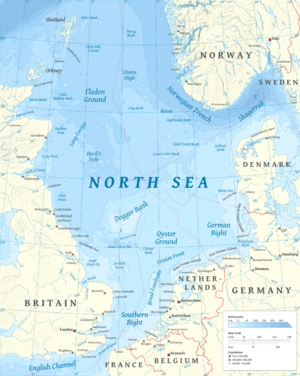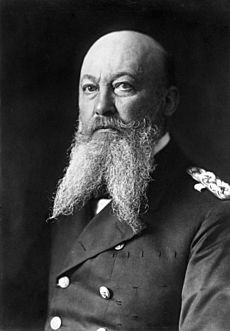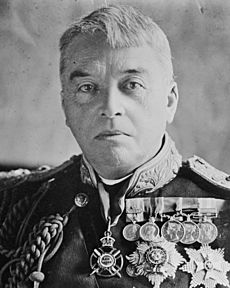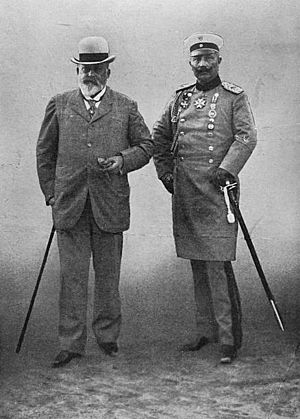Anglo-German naval arms race facts for kids
The arms race between Great Britain and Germany was a big competition to build the best and biggest navies. It happened from the late 1800s until World War I started in 1914. This race was one of the main reasons why the war began.
The relationship between Germany and Britain had been getting worse for many years. The naval race really kicked off in 1897. German Admiral Alfred von Tirpitz came up with a plan. He wanted to build a strong German navy, called a "fleet in being". His goal was to make Britain nervous enough to agree to Germany's demands. Tirpitz didn't actually think the Imperial German Navy could beat the powerful Royal Navy.
With the support of Kaiser Wilhelm II, Tirpitz started passing new German Naval Laws. These laws allowed Germany to build more and more large warships. Then, in 1906, Britain launched a revolutionary new battleship called HMS Dreadnought. This ship was so advanced it made all other battleships seem old. This pushed Tirpitz to build even more ships faster.
At first, some British people were worried about Germany's growing navy. But most weren't truly alarmed until Germany's naval bill of 1908. After that, the British public and politicians demanded action. They wanted their government to match Germany's challenge. This led to Britain funding more dreadnoughts in 1910, making the arms race even more intense.
Germany had the largest army in Europe and the second-largest navy. Keeping both was incredibly expensive. Theobald von Bethmann Hollweg, who became Germany's leader in 1909, tried to make peace with Britain. He wanted to ease the financial pressure. Germany then decided to focus on its rivalry with France. From 1912 onwards, Germany stopped trying to match Britain in dreadnoughts. Instead, they focused on a new naval strategy: commerce raiding using submarines. This meant attacking enemy merchant ships.
It's interesting that the German battle fleet only fought one major surface battle, the Battle of Jutland, which didn't have a clear winner. It never really threatened Britain's control of the seas. However, the commerce raiding strategy, which was Germany's original naval idea, caused huge problems for British shipping and imports throughout the war. The success of German submarines in World War I greatly influenced Germany's naval plans before World War II. They planned to use both U-boats and fast, strong battlecruisers to attack enemy trade.
Contents
Britain had the biggest navy in the world. Its rule was to make sure the Royal Navy was at least as big as the next two largest navies combined. This was called the "two-power standard". Britain's economy relied on ships bringing in raw materials and taking out finished goods. By 1900, over half the food eaten by British people came from overseas. This meant that if their navy couldn't protect the seas, Britain would face severe food shortages.
Even before Germany's challenge, British leaders worried about what would happen if their navy couldn't keep the seas safe. This fear led to popular books about invasions, which influenced public opinion.

The first leader of a united Germany, Otto von Bismarck, was very skilled. He made sure Germany didn't get too tied to any other European power. But after he left in 1890, Germany's foreign policy changed. It became more committed to the Triple Alliance with Austria-Hungary and Italy.
A German official named Friedrich von Holstein convinced the new leader, Leo von Caprivi, not to renew a treaty with Russia in 1890. Bismarck had created this treaty to stop Russia from joining with France. But when it ended, Russia looked for new friends who could help with their debts. This led to the Franco-Russian Alliance a few years later. Holstein had hoped that ending the treaty would bring Germany closer to Britain. But this didn't happen. From 1890 to 1897, Germany's leaders couldn't decide if they wanted to be closer to Britain or Russia.
In 1890, Alfred Thayer Mahan, an American naval officer, wrote a very important book. It was called The Influence of Sea Power upon History. Mahan argued that control of the sea was key for strong nations to succeed. He believed that the best way to control the sea was through big battles between large fleets. At the time, the German navy focused on attacking merchant ships. But Mahan's ideas greatly influenced both German and British naval thinking.
Mahan's book was translated into German. A copy was placed on every German naval ship. Kaiser Wilhelm II loved Mahan's ideas after reading the book in 1894. He immediately asked the German parliament, the Reichstag, for money to build a bigger navy.

In 1895, the Reichstag only approved four of the thirty-six cruisers Wilhelm wanted. They approved none at all in the next two years. Frustrated, Wilhelm called Alfred von Tirpitz back from his duties in Asia. In 1897, Tirpitz became the head of the German Imperial Naval Office. Tirpitz believed in Mahan's ideas about battle fleets. In 1894, he wrote that a navy's main goal should be to attack. He said Germany needed to prepare for offensive sea battles to secure its place in the world.
In his first meeting with Wilhelm in June 1897, Tirpitz argued that Germany needed to challenge Britain. He said this was necessary for Germany to be a major European power. He also explained his long-term plan: build a German navy strong enough that Britain couldn't destroy it without leaving itself open to attacks from France and Russia. This was his version of Mahan's "fleet in being". Tirpitz believed that if Britain tried to destroy the German fleet, its own navy would be spread too thin around the world. He thought a big battle would happen near the Thames. Both Tirpitz and Bernhard von Bülow, who was Germany's foreign minister and then leader, believed this strategy would force Britain to negotiate with Germany as an equal. They even hoped Britain might join Germany's alliance.
Germany Builds Its Fleet (1898–1912)
Kaiser Wilhelm II was very keen on expanding the German navy. Tirpitz had a clear plan. Between 1898 and 1912, five new Fleet Acts were passed. These laws greatly expanded the German High Seas Fleet. Germany aimed to build a fleet that would be two-thirds the size of the British navy.
The First Naval Act passed in March 1898. Wilhelm, Tirpitz, and Bülow worked hard to get public support for it. This act funded the building of eleven battleships over the next seven years. Britain wasn't too worried about this first act. It didn't make Germany's navy big enough to challenge Britain's "two-power standard."
However, by November 1898, Tirpitz was already planning to double the fleet. He wanted forty-five battleships and armored cruisers. He showed this plan to the Kaiser in September 1899. The timing was good. The Second Boer War had just started, and Britain seized a German ship. This made the German public very angry at Britain. So, the Reichstag easily passed the Second Navy Law in June 1900.
The Amazing HMS Dreadnought

The Second Naval Act in Germany made British leaders more worried. In 1902, Selborne, Britain's top naval official, told his government that Germany was building its navy to fight Britain. In 1904, Admiral Jacky Fisher became the head of the Royal Navy. He completely reorganized the navy. He brought most of Britain's ships closer to home. He also set up a team to design a new "super battleship." After the Battle of Tsushima in May 1905, it was clear that these new battleships were the future of naval warfare.
HMS Dreadnought was launched in February 1906. It was built in just 14 months! Jane's Fighting Ships, a famous book about warships, said that HMS Dreadnought was as powerful as two or three regular battleships.
In early 1905, Germany's naval expert in Britain told Tirpitz that Britain was planning a new type of battleship. That summer, Tirpitz decided Germany would match Britain's shipbuilding. It's surprising that Tirpitz made this huge decision without talking to other German leaders. He didn't consult the chancellor, the foreign ministry, or even other naval offices.
He presented his new naval bill to the Reichstag. It asked for a 35% increase in spending to build two dreadnoughts and one armored cruiser each year. This bill faced strong opposition because Germany's budget was already tight. But then, the Algeciras Conference in April 1906 made Germans angry at Britain and France. This nationalist feeling helped the third naval law pass easily in May 1906.
Wilhelm and Tirpitz believed Britain was working with France and Russia to surround Germany. Tirpitz thought Britain had made a mistake by building expensive dreadnoughts. He believed Britain would realize this if Germany kept building them too. German leaders also worried about a surprise British attack, like the 1807 Battle of Copenhagen. Fears grew, and so did nationalist feelings. Some Germans criticized the Social Democratic Party for wanting less defense spending and more peace.
From 1905 onwards, Admiral John Fisher planned to blockade the German coast. This became a central British strategy and was used in 1914. In 1906, Fisher said Germany was the "only probable enemy." He believed the Royal Navy should keep a force twice as powerful as Germany's navy close to Germany's shores. Eyre Crowe of the British Foreign Office wrote a memo in 1907. He urged strong resistance to what he saw as Germany's attempts to dominate Europe. He argued that even if Germany's actions were confused, they still threatened British security.

In March 1908, Tirpitz got a fourth naval bill passed. This bill increased the building rate of new battleships. Germany would build four per year for the next four years, then three per year. If this plan continued, Germany would have 21 dreadnoughts by 1914. Tirpitz still thought Britain wouldn't be alarmed. He told Kaiser Wilhelm the bill looked "as small and harmless as possible."
Tensions rose during the Bosnian crisis. Chancellor Bülow, who had to find the money for the military, started to doubt Tirpitz's plan. It was very expensive and seemed to make Germany more isolated. Germany's national debt had doubled between 1900 and 1908. Most of the national budget went to the military. Bülow began to think Germany couldn't afford both the largest army and the second-largest navy.
Even though the German ambassador in London reported that the naval buildup was making Britain dislike Germany, Tirpitz disagreed. He said the conflict was about economic rivalry, not navies. Tirpitz also argued that Germany had already spent too much money to stop the naval program. He worried that stopping would upset the political groups that supported it. Facing a growing budget problem, and without the Kaiser's full support, Bülow resigned in July 1909.
Before Germany's 1908 naval bill, Britain mostly ignored the buildup. But some people in the military and government were already very aware of the danger. In December 1907, the Admiralty (Britain's navy department) even suggested building fewer battleships. This fit with the Liberal government's goal to spend more on social programs and less on overall government costs. This was under the new Prime Minister H. H. Asquith in May 1908.
However, after the 1908 German bill, public and government alarm grew in Britain.
In August 1908, King Edward VII visited his nephew Wilhelm in Germany. He had a paper about British concerns but decided not to bring up naval spending. He didn't want to spoil the friendly mood. Wilhelm happily told a British official that he thought relations between Germany and Britain were very good. The British official politely disagreed. He said Britain was worried about Germany's naval buildup. He warned it would likely lead to Britain building more ships, causing a naval rivalry and increasing tensions. Wilhelm sharply replied that Britain had no reason to worry. He said the German naval bill didn't threaten the balance of power. They didn't reach an agreement. Wilhelm left the meeting believing he had convinced the British.
A series of events made British tensions worse. In autumn 1908, the British naval expert in Berlin reported that Germany was building an extra battleship. This was actually because a shipbuilder wanted an early contract to avoid laying off workers. Then, on October 28, The Daily Telegraph newspaper published what it called an interview with the Kaiser. The Telegraph sent the article to Wilhelm for approval. He passed it to Chancellor Bülow, who passed it to the Foreign Ministry. But it seems no one at the Foreign Ministry reviewed it.
In the published article, Wilhelm seemed to complain and accuse. He said the British were "mad" because they didn't realize Germany was their good friend. He also said the naval buildup was not aimed at Britain, but at Japan. This event, known as the Daily Telegraph Affair, was seen in Britain in different ways. Some thought Wilhelm was mentally unstable. Others thought it was a sneaky plan to influence British public opinion. German leaders were shocked that their Kaiser would make such a public mistake. Nationalists were furious about Wilhelm's claims of friendship with Britain. Left-wing groups believed the Reichstag needed more control over the Kaiser. Wilhelm and his power were severely weakened, and he became very depressed. Wilhelm never forgave Bülow for allowing the article to be published. This was one reason Bülow left office in July 1909.
After the German bill, the British Admiralty dropped its plan to build fewer ships. In December 1908, they suggested building at least six more dreadnoughts. Some government officials, like Chancellor of the Exchequer David Lloyd George and President of the Board of Trade Winston Churchill, opposed this because of the cost. They saw military spending as a threat to the welfare reforms promised by the Liberal Party. Lloyd George warned Prime Minister Asquith that Liberal politicians would rebel against a plan that added an estimated £38 million to the navy budget.
However, the Conservative opposition, the Navy League, and British arms industry all pushed for the spending. King Edward VII also supported building eight more dreadnoughts. A Conservative politician came up with a popular slogan: We want eight and we won't wait!
In response to this strong support for more naval power, Asquith found a compromise in February 1909. They would start building four dreadnoughts in the next financial year. They would build four more by spring 1910 if needed. With the Liberals' support, the government defeated a challenge from the Conservatives. Lloyd George included the money for the extra dreadnoughts in his "People's Budget" in April 1909. But the House of Lords rejected this budget in November 1909. They were angry about the plans to redistribute wealth.
Asquith then called an election in January 1910. His government lost its majority but stayed in power with support from the Irish Parliamentary Party. After the election, the House of Lords stopped opposing the People's Budget. This included funding for the dreadnoughts, which passed in April 1910. This was a major step up in the arms race.
The End of the Arms Race (1912–1914)
In 1912, German Chancellor Theobald von Bethmann Hollweg ended the naval arms race. He wanted to reach an agreement with Britain to stop Germany from becoming more isolated. Russia's military was growing, which made Germany decide to spend more on its army and less on its navy. This policy was called the Rüstungswende, or ‘armaments turning point’.
This led to the Haldane Mission, where Germany offered to accept Britain's naval superiority. In return, Britain would stay neutral if Germany went to war, as long as Germany wasn't the attacker. Britain rejected this idea. They felt they had nothing to gain, as their naval superiority was already secure. But the British Foreign Secretary Sir Edward Grey wanted a stronger policy against Germany.
By 1913, there was a big debate in Britain about new ships. This was because of Fisher's ideas and money problems. Historians now generally agree that in early 1914, Germany decided to build submarines instead of new dreadnoughts and destroyers. This effectively ended the arms race. But they kept this new policy a secret, so other countries didn't immediately follow suit.
By the start of World War I, Britain had 20 commissioned dreadnoughts and 9 battlecruisers. Germany had 15 commissioned dreadnoughts and 7 battlecruisers.
| Country | Personnel | Large Warships (dreadnoughts) |
Total Ship Weight |
|---|---|---|---|
| Russia | 54,000 | 4 | 328,000 |
| France | 68,000 | 10 | 731,000 |
| Britain | 209,000 | 29 | 2,205,000 |
| Total | 331,000 | 43 | 3,264,000 |
| Germany | 79,000 | 17 | 1,019,000 |
| Austria-Hungary | 16,000 | 3* | 249,000 |
| Total | 95,000 | 20 | 1,268,000 |
| Grand total | 426,000 | 63 | 4,532,000 |
| *The 4th ship was not yet ready. | |||
See Also
- Argentine–Chilean naval arms race
- Austro-Italian ironclad arms race
- Causes of World War I
- Germany–United Kingdom relations
- Imperial German Navy
- International relations of the Great Powers (1814–1919)
- South American dreadnought race





